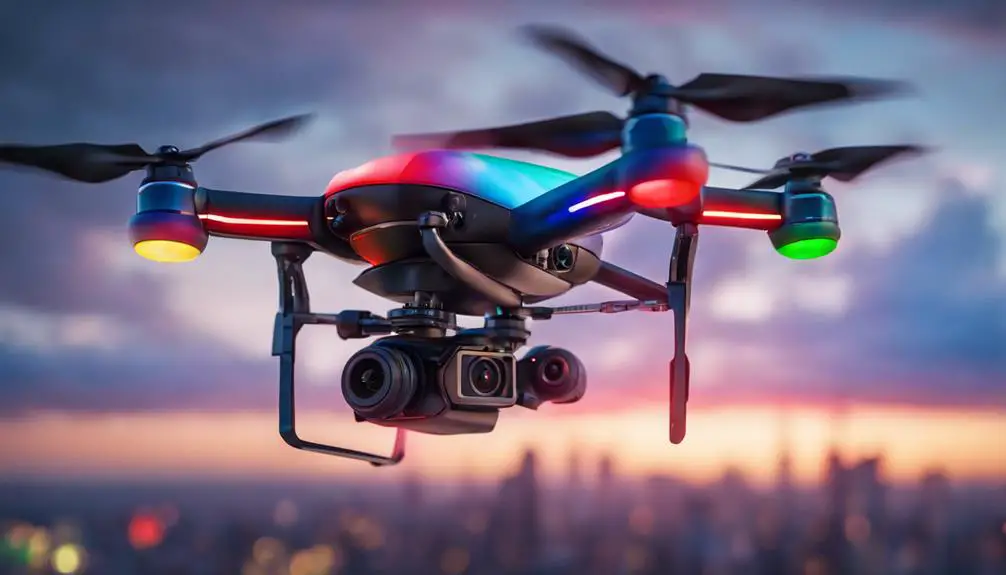Yes, most drones do have lights. These lights enhance visibility and safety, especially during night flights. You'll find navigation lights that help indicate the drone's position and orientation. There are also illumination lights for exploring and capturing footage. Additionally, signaling lights notify others about the drone's status, minimizing collision risks. Bright LED options can even create stunning aerial displays, adding an artistic touch to your flights. Understanding how these lights function can improve your flying experience and safety. Keep exploring to uncover more about the fascinating technology behind drone lights and their various uses.
Types of Drone Lights
When it comes to drone lights, there are several types designed for different purposes, including navigation, illumination, and signaling. You've got navigation lights that help you see your drone's position in the sky, keeping you aware of its orientation. Illumination lights brighten up the area below, making it easier to explore or capture footage in low-light conditions. Then there are signaling lights, which can communicate your drone's status or intentions, helping you stay in sync with other pilots and avoid collisions. Each type serves a unique function, giving you the freedom to operate your drone safely and effectively, no matter the environment. Understanding these options equips you to harness your drone's full potential.
Purpose of Lights on Drones
The primary purpose of lights on drones is to enhance visibility and safety during flight, helping pilots navigate effectively in various conditions. These lights allow you to spot your drone from a distance, especially in low-light environments. They're essential for avoiding obstacles and ensuring that you maintain awareness of your drone's position. Additionally, colored lights can indicate your drone's orientation, making it easier to control during complex maneuvers. If you decide to fly in crowded areas, having lights can also help others see your drone, promoting safety for everyone. Ultimately, the right lighting setup gives you the freedom to explore the skies confidently, knowing you're minimizing risks while enjoying your aerial adventures.
Night Flight Regulations
Flying drones at night requires adherence to specific regulations to confirm safety and compliance with local laws. Before you take off, make certain you've registered your drone and obtained the necessary permits for night flying. Most areas require you to keep your drone within visual line of sight, which can be challenging after dark. You'll also need to be aware of any local restrictions, such as no-fly zones or curfews. Failing to comply with these rules can lead to fines or even loss of your flying privileges. Embrace your freedom, but remember: responsible flying at night confirms not just your safety but also that of others around you. Always stay informed and navigate the skies wisely!
Enhancing Aerial Visibility
To guarantee your drone stands out in the night sky, consider equipping it with bright LED lights that enhance visibility and safety. These lights not only help you keep track of your drone but also make it more visible to others, reducing the risk of collisions. Whether you're flying for fun or capturing stunning aerial footage, having your drone clearly seen is essential. You can choose from various colors and flashing patterns to suit your style while ensuring it remains noticeable. Plus, some models come with built-in lights, so you might not need extra accessories. With proper lighting, you'll enjoy the freedom of the skies without worrying about losing sight of your drone or endangering others.
Lights for Aesthetic Appeal
Adding colorful LED lights not only enhances your drone's visibility but also transforms it into a stunning aerial spectacle that captures attention. Imagine flying your drone at dusk, its vibrant lights painting the sky with a mesmerizing display. It's not just about function; it's about expressing your creativity and individuality.
With a variety of colors and patterns available, you can customize your drone to reflect your personality or match the mood of an event. Whether you're participating in a night race or capturing breathtaking footage for an adventure video, those lights create an unforgettable visual experience.
Technology Behind Drone Lighting
Understanding the technology behind drone lighting reveals how advancements in LED and control systems enhance both visibility and creative expression in aerial photography. Today's drones often utilize high-efficiency LEDs that provide vibrant colors and a range of brightness levels. These lights can be customized and programmed, allowing you to set specific patterns or sequences that suit your vision.
Moreover, smart control systems enable seamless integration with the drone's flight controls, ensuring that your lighting adjusts automatically based on altitude or speed. This means you can focus on capturing that perfect shot without worrying about visibility. With this tech, you can explore new horizons, releasing your creativity and freedom as you illuminate the skies in ways never seen before.
Future of Drone Lighting
As drone technology evolves, lighting systems are likely to become even more sophisticated, offering unprecedented versatility and creativity for aerial photography. Imagine being able to customize light patterns or colors on-the-fly, allowing you to capture stunning visuals that reflect your unique vision. Future drones could feature integrated smart lighting, responding to environmental conditions and enhancing visibility during night flights or low-light situations.
You might also see advancements in energy-efficient LEDs, extending flight times while maximizing illumination. With advancements in AI, drones could autonomously adjust lighting based on your preferences or the scene at hand. This newfound freedom in lighting could transform how you explore and document the world, pushing the boundaries of creativity and expression in aerial imaging.

